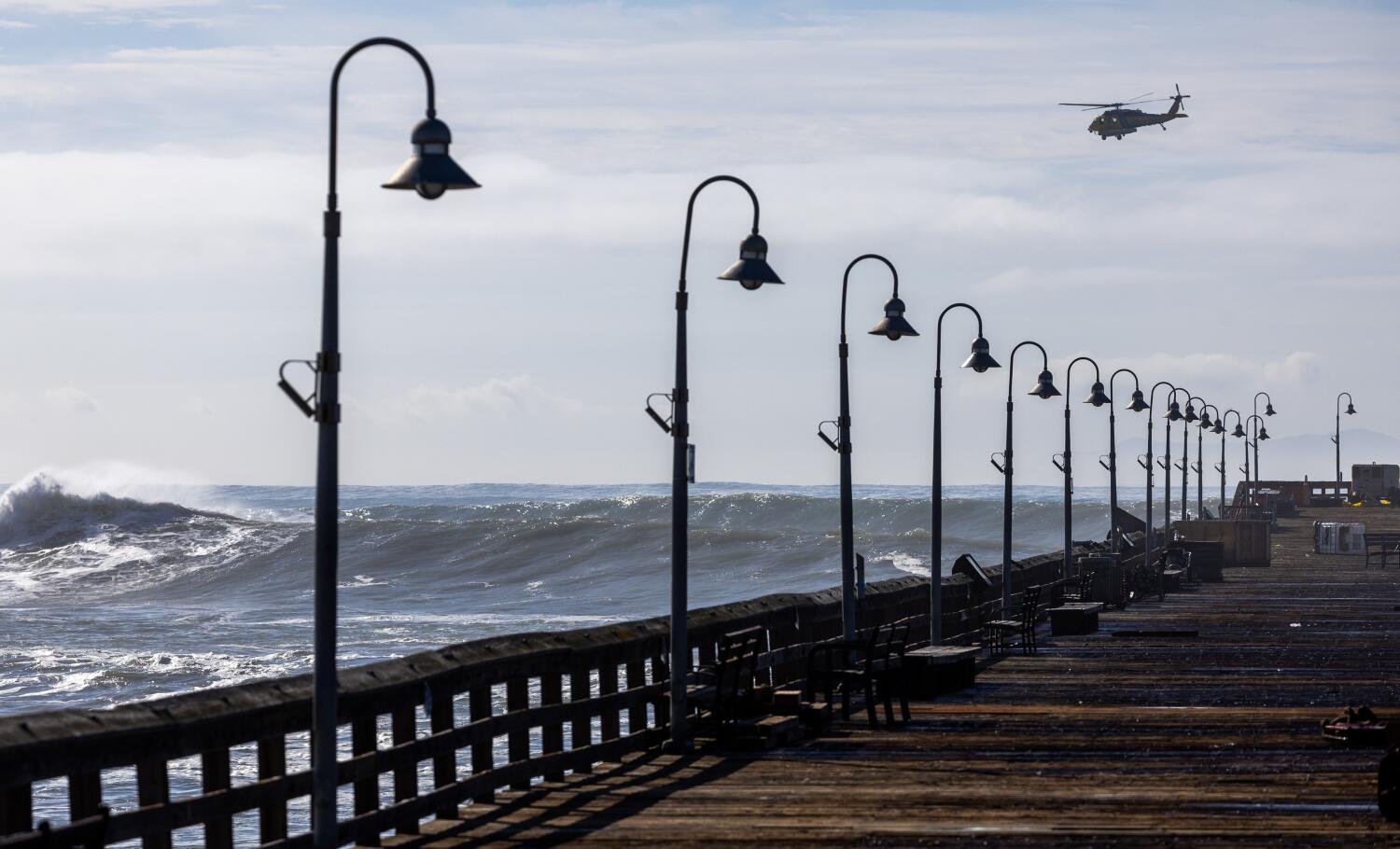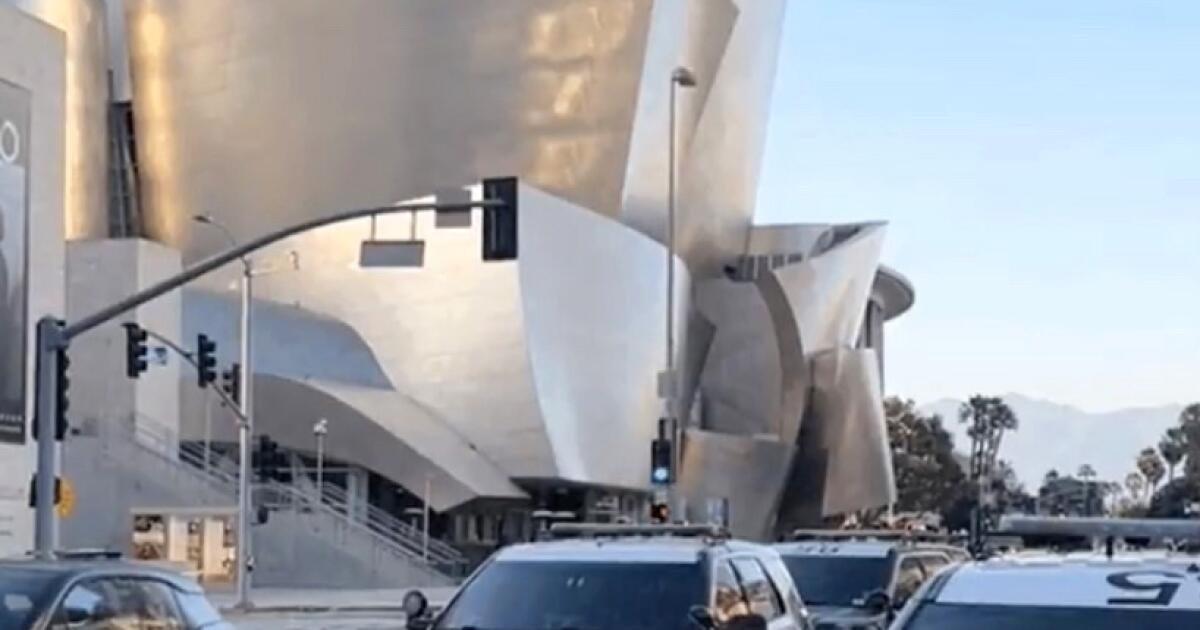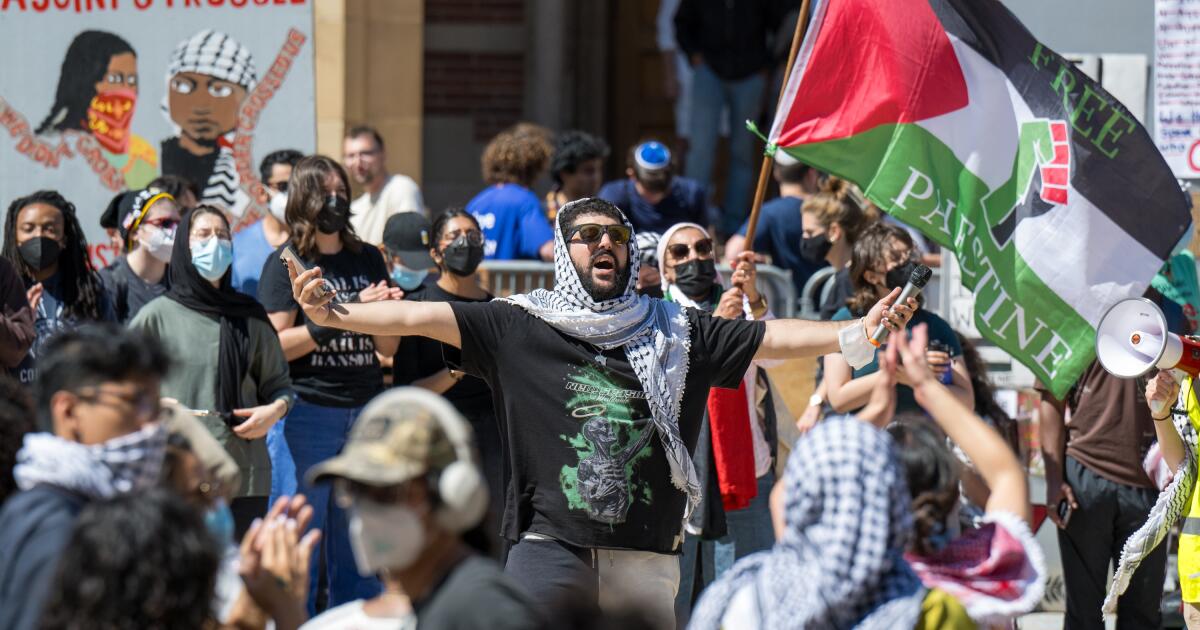World News
Pro-Palestinian encampment at Cal State L.A. is shut down


Dozens of officers in riot gear from multiple agencies descended Monday afternoon on a pro-Palestinian encampment at Cal State L.A. to dismantle the camp and force protesters to leave after tensions escalated last week.
About 1:20 p.m., police issued a dispersal order in English and Spanish, and the seven remaining protesters in the encampment left voluntarily, said university spokesperson Erik Frost Hollins.
Officers, who included those from the LAPD, California Highway Patrol and multiple Cal State campus police departments, did not use any weapons to remove protesters and made no arrests, Hollins said. Campus security and police blocked all road entrances to campus, although exits were open, and the campus was accessible by foot.
Using forklifts and large dumpsters, crews took down the painted and graffitied wooden boards that encircled the encampment and hauled them away. Many were painted in the red, green, white and black colors of the Palestinian flag and bore phrases including “Gaza Solidarity Encampment” and “Google LASD gangs.”
Students launched the camp on May 1 to demand that Cal State L.A. and the California State University system disclose its investments, “divest from companies that financially and materially support genocide, defend the Palestinian people’s rights of resistance and return, and declare that the genocide in Gaza and occupation of Palestine is illegal under international law,” according to a statement from the Students for Justice in Palestine at Cal State L.A.
Hollins said that, since the encampment launched, Cal State L.A. President Berenecea Johnson Eanes had visited it twice and held several conversations with protesters.
While other universities, including USC and UCLA, moved in relatively quickly to shut down pro-Palestinian encampments over the spring, the one at Cal State L.A. was tolerated for many weeks. For the most part, it hasn’t been a site of heated controversy or clashes involving students, campus officials or police.
But the nature of the relationship between the university and protesters changed Wednesday, Hollins said, when several dozen protesters barricaded themselves inside the student services building, with some administrators inside, for more than nine hours. The Students for Justice in Palestine group said that administrators were free to leave, with escorts, whenever they desired. The group said it communicated that message directly and via Instagram. About 60 staffers were in the building for roughly two hours before exiting. Around a dozen, including Eanes and Hollins, voluntarily remained behind.
Hollins said there was no specific event on Monday that spurred the university to call in police but said officials had been talking about taking the encampment down since the building occupation.
On Monday afternoon, Eanes said in a campus-wide email that “those associated with the encampment engaged in unlawful acts that put staff and students” at risk during the building occupation, “including assault, vandalism, destruction of property, and looting.”
“The only acceptable option for the safety of the entire campus community was for the encampment to disband and disperse. We will not negotiate with those who would use destruction and intimidation to meet their goals,” she wrote. “It does not escape me that public employees serving a public mission at a public university in one of the region’s most under-resourced communities have been victimized by those claiming to protest injustice.”
Eanes said the campus, where classes have been virtual since the middle of last week, would continue virtually on Tuesday. The university is in its summer session, which ends Aug. 10.
On Monday, the Cal State L.A. chapter of Faculty for Justice in Palestine said it had remained concerned for weeks that the peaceful encampment might be compromised as negotiations stalled and frustrations mounted.
“While the protest of June 12th produced a turning point for the encampment, we propose that timely, good faith negotiations with the students over their divestment demands is the best route to a resolution,” the group said in a letter posted on Instagram. “We also recommend that you communicate more clearly with the encampment students about a timeline and process for decampment, rather than resort to an unannounced possible sweep that is likely to produce trauma, harm, and violence as it has at other universities.”
An Instagram post by Students for Justice in Palestine at Cal State L.A. showed a video of what appeared to be activists talking to police in riot gear who were gathered outside the camp’s barricades. “We have to do whatever they say,” a voice from the camp says in the background. “Can we leave?” an activist says to police as the activist looks out at law enforcement. “Yes!” several officers say in unison. “I want you to go,” an officer says. “I want less of you in there.”
The encampment was nearly dismantled by 5:30 p.m. Its removal revealed graffiti covering the wall below the “Olympic Fantasy” tile mural near the heart of campus, with slogans such as “Gaza lives” and “Stop funding genocide.”
The student services building, the site of last week’s occupation, remained closed off with police tape. Tables and chairs were turned over on its patio, and graffiti remained across its ground-level windows.
A campus security worker not authorized to speak to media said officials would clean up the building area after the camp materials were fully removed. They said they weren’t sure whether that would happen Monday.
Onlookers, including students and neighborhood residents, expressed surprise at the encampment’s removal and the police presence Monday.
“I did not agree with what the camp stood for, but I walked by it many times,” said James Wheeler, who walked over to the encampment area — cordoned off with yellow police tape — while a helicopter flew above.
“These were mostly peaceful students,” Wheeler said, “and their protest was nothing like the conflict or controversy you have seen at other colleges, aside from the one time they went to occupy the building.”
A student who said she knew members of the encampment said the police response was “way overblown” considering it was about 10 activists who voluntarily left the scene. “They sent in all these police cars, these riot police, blocked off the streets, all for nothing. It’s out of control,” said the student, who declined to share her name.
In her letter Monday, Eanes said the university would “need to confront the aftermath of sheltering inside [the student services building], the anger at the destruction of student spaces they worked so hard to create, and the grief of feeling less safe on a campus we all cherish.”
Hollins said, during the sit-in, one employee had “something thrown at their head,” while another was pushed into the door and then out of the way as protesters forced their way into the building.
Protesters vandalized the building heavily, Hollins said, and the university is still investigating to determine whether there should be arrests. Protesters covered their faces and took other steps to hide their identities, which complicates the investigation, they said.
Activists defended their actions.
“The defense of the sit-in and the Solidarity Encampment will continue despite heavy police pressure from the University Police Department, the Los Angeles Police Department, and the Los Angeles Sheriff’s Department until CSULA ends its financial and material support for genocide,” the group said in a statement last week.
Times staff writer Angie Orellana Hernandez contributed to this report.
World News
India Wins T20 Cricket World Cup, Stamping Its Domination of the Sport

India won the men’s Cricket World Cup on Saturday, defeating South Africa to end a dry spell in tournament victories that had lasted over a decade, even as the nation was dominating the sport globally in other measures like talent, cash and influence.
The tournament was played across several Caribbean islands, with a few of the matches hosted in the United States, including at a pop-up stadium in New York. When the final, in Barbados, ended with India declared the champion, it was close to midnight back home, where joyful crowds poured into the streets across several cities.
“Maybe in a couple hours it will sink in, but it is a great feeling,” said Rohit Sharma, India’s captain, who took a tour of the stadium with his daughter propped on his shoulders to thank the crowd. “To cross the line — it feels great for everyone.”
It was a closely fought match, and a deeply emotional one for India, in part because many of its senior players, including Sharma, 37, were near the end of their careers. India last won the World Cup in T20, the shortest format of cricket, in 2007, when Sharma was just getting started. The top prize had also evaded Virat Kohli, 35, one of cricket’s most recognized icons. Rahul Dravid, India’s coach, had never won a World Cup during his long and illustrious career as a player.
All three men ended the night on a happy note, with Sharma and Kohli announcing their retirement from the fast-paced short form of the game. Dravid, who finished his stint as India’s coach, is normally a quiet, stoic presence. But after the win, he was screaming and celebrating.
India’s president, Droupadi Murmu, and prime minister, Narendra Modi, both congratulated the team. “In the field, you won the World Cup. But in India’s villages, streets, and communities, you won the hearts of our compatriots,” Mr. Modi said in a video message.
Cricket, followed by hundreds of millions of people, is a crucial part of India’s global brand — perhaps even more important than the country’s film industry. The governing body of cricket in India has at times been accused of using its outsize economic heft to dictate terms around global cricket events, reflecting its status as the richest contributor and a destination for the world’s best players.
The start of the Indian Premier League in 2007 transformed a sport that was once seen as slow and short of cash. In just 17 years, the league’s brand value has surpassed $10 billion, making it among the richest sports leagues in the world. Players routinely earn contracts worth over $1 million for a season that lasts about eight weeks, with some of the highest-paid bagging close to $3 million.
Last year, India launched the I.P.L.’s sister league, the Women’s Premier League, with $500 million — an investment similar to the one that started the men’s league — and is already expanding opportunity for women in India and for talent from around the world. The league’s wealth has meant more investment at the grass roots to develop more players. Female players long in the shadow of the men’s game are now finding brand endorsements, more TV viewers and thousands showing up for their matches at stadiums.
And the foreign players in both the leagues — all with large followings at home — are a public relations boost for India as they travel around to play, using social media to post admiration for the culture of a vastly diverse country.
In India, a cricket-crazy nation that closely follows the players’ every move on and off the field, many of this generation of stars have been role models that could help the country move the needle on social issues, particularly about a public life that remains male-dominated.
Sharma, the captain, who is married to a sports management professional, and Kohli, who is married to an actor, often speak of the role of their partners in their careers. Sharma’s wife, Ritika Sajdeh, and their daughter are often at his side during tours, while Kohli is frequently seen video-calling his family from the stadium after matches.
“Our daughter’s biggest concern was if all the players had someone to hug them after she saw them crying on TV,” Anushka Sharma, Kohli’s wife, posted on social media after the win.
Jasprit Bumrah, who was named the World Cup’s most valuable player, found himself doing his post-award interview with his wife, the broadcaster Sanjana Ganesan. This was a working couple on tour. Behind them amid the celebrations was their 10-month-old baby being looked after in a stroller.
“Thank you so much for talking to us, Jasprit, and all the best for—” Ms. Ganesan began as she wrapped up the interview. But her husband went in for a hug before she finished speaking and then ran back to join his teammates in celebrating.
World News
Euro 2024: Spain v Georgia – Nico Williams’ remarkable journey to the top

Despite their new found security, life was far from easy for the Williams family. They moved 150 kilometres south east to Pamplona.
Nicholas Williams Arthuer was born there on July 12, 2002, but unable to find enough work to keep his family, Felix moved to London doing whatever he could to send money home.
He cleared tables in a food hall in a Chelsea shopping centre and worked as a security guard, even on the turnstiles at Chelsea FC.
He was away for 10 years – he is back in Bilbao now – during which time Inaki became like a father to Nico, while their mother worked up to three jobs at a time in her efforts to provide for her family.
When they go for lunch at their mum’s, she reminds them to clear the table, wash the dishes, and tells them off if they step out of line. The education from their parents is constant.
Inaki, who decided to play for Ghana as a homage to them, would watch over Nico all the way.
From picking him up from school and giving him a ‘bocadillo’ (sandwich) when they come out of class, to later instructing him in the behaviour that he needed to follow if he wanted to make it as an elite athlete.
“For me he is a reference, he is everything for me,” said Nico. “He has helped my parents and me so that we can eat, so that I could go to class, so that I could get dressed.
“He corrects me, he advises me, he has always done it actually, but we get along very well. He is my brother, but he also acts as a father a little.”
On 28 April 2021, the brothers were brought on as second-half substitutes in Athletic’s 2-2 draw at home against Real Valladolid to become the first siblings to play for the club together since 1986.
After the final, they immediately went to visit their mum, who was unable to watch the match as fans were banned from the stadium because of the Covid pandemic.
World News
Ventura Pier reopens after a year-and-a-half closure caused by storm damage


Ventura’s famous pier reopened Saturday after massive waves damaged the landmark last year.
Social media posts and news video footage showed people striding onto the pier early Saturday, carrying fishing poles, coolers and folding chairs. The pier — the oldest in California — is a popular fishing and sight-seeing spot and draws tourists, families and lovebirds.
“The Ventura Pier is open!” the city of Ventura announced on its X feed.
High surf from a winter storm pummeled the boardwalk in January 2023. In December, another storm swept through, causing more damage to the pier’s piles and braces.
Mary Joyce Ivers, deputy public works director in Ventura, told KTLA that the city had to replace 37 timber piles, which hold up the deck of the pier, as well as 100 pieces of hardware and cross-bracing and 3,000 square feet of deck board.
“It’s such an important piece of our city,” Ivers told KTLA. “It’s such a great landmark and so many great things happen on this pier for families and our community.”
The repairs cost at least $3.3 million, with the federal government and the state expected to pick up the tab, according to a city news release.
The pier, first built in 1872 as a private commercial wharf, has been repaired or rebuilt countless times throughout its history. It closed in 1992 for 13 months after it was clobbered by waves and reopened after a $3.5-million restoration.
More recently, it closed in 2015 for several months for repairs after another storm.
Ventura purchased the pier for $7,000 in 1940 but gave it to the state in 1949.
In 1990, the city moved to take it back after state officials said they were considering demolishing the structure because of the high maintenance costs.
-

 African History5 years ago
African History5 years agoA Closer Look: Afro-Mexicans 🇲🇽
-

 African History5 months ago
African History5 months agoBlack History Facts I had to Learn on My Own pt.6 📜
-

 African History5 years ago
African History5 years agoA Closer Look: Afro-Mexicans 🇲🇽
-

 African History1 year ago
African History1 year agoMajor African Tribes taken away during the Atlantic Slave Trade🌍 #slavetrade #africanamericanhistory
-

 African History1 year ago
African History1 year agoPROOF AFRICAN AMERICANS AIN'T FROM AFRICA DOCUMENTED EVIDENCE
-

 African History1 year ago
African History1 year agoCameroon 🇨🇲 World Cup History (1962-2022) #football #realmadrid #shorts
-

 African History5 months ago
African History5 months agoBlack History Inventors: Mary Kenner 🩸
-

 African History4 months ago
African History4 months agoMr Incredible Becoming Canny/Uncanny Mapping (You live in Paraguay 🇵🇾)





























